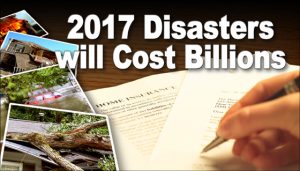Mother Nature Having One Hissy Fit After Another This Year
We have just passed mid-October, and 2017 weather disasters continue to unfold. Blizzards, droughts, floods, freezes, hail, hurricanes, tornadoes, wildfires— there seems to be no end to the calamitous climate-driven catastrophes this year across the U.S.
 Billions of Losses from Weather Disasters
Billions of Losses from Weather Disasters
National Centers for Environmental Information (NCEI) tracks weather-related events annually, both in the U.S. and globally. By compiling the data year after year, the NCEI documents climate trends and weather extremes.
Looking at 1980-2016 for the U.S., NCEI data shows an average of 5.5 major disasters per year top the $1 billion-in-losses mark. So far this year, NCEI reports 15 separate $1 billion+ calamities. The list includes:
- Drought in North Dakota, South Dakota, and Montana during the summer and fall
- Flooding in California in February
- Flooding in Missouri and Arkansas and severe weather in Central U.S., April 25- May 7
- Freeze across the Southeast from March 14-16
- Hail and severe weather in Minnesota and the upper Midwest, June 9-16
- Hail in Colorado and the Central U.S. in early May
- Hurricane Harvey, August 25-31; estimates place losses as high as $108 billion
- Hurricane Irma, September 6-12; possibly topping $92 billion in losses
- Hurricane Maria, September 19-21; Puerto Rico losses alone may top $72 billion
- Thunderstorms across the Midwest in late June
- Thunderstorms in the South/Southeastern states in late March
- Tornado outbreak in the South, January 20-22
- Tornadoes across the Central/Southeast on February 28-March 1
- Tornadoes in the Midwest, March 6-8
- Wildfires, many still raging across the Western U.S., killing 41 people and consuming over 8.8 million acres as of today
Certainly, there were many more climate-related disasters across the U.S. in the less-than-billion dollar range, as well.
Will the Trend Continue?
The NCEI operates as part of the National Oceanic and Atmospheric Administration (NOAA). NOAA expects this inclination of costly disasters to continue in the future based on three factors:
- Climate change seems to be increasing the frequency of billion dollar weather disasters
- Recent data shows a clear trend toward escalating power in extreme weather events: heavier rains and flooding, extreme heat waves and droughts, lengthier violent thunderstorms, stronger hurricanes
- People continue to build high-value properties in risky areas— flood plains and coastlines in particular. The denser the population is in these areas, the greater the risk of billion-dollar catastrophes.
Preparing for Weather Calamities
What can we do to reduce our risk of property damages from weather disasters?
We can build smarter, build stronger, and build safer.
No type of structure can claim complete immunity to damage from catastrophic climate events. However, one building method outshines all others in standing up to Mother Nature at her worst: commercial-grade pre-engineered steel buildings.
Our next blog details the many ways RHINO steel buildings resist damage from high winds, fire, heavy snows and rains, earthquakes, and the passage of time.
In the meantime, check out the RHINO photo gallery and our current building specials. To speak to a friendly RHINO metal building specialist now, call 940.383.9566.
